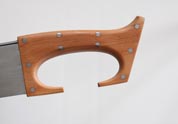
 |
 |
The war knife and single edged sword has an ancient history in Europe that is rather obscured by the interest for the double edged sword, as seen in the Knightly sword of the medieval period.
Some of the earliest finds of iron swords in northern europe are single edged swords or war knives. An important early example is the sacrificial deposit of Hjortspring in Denmark. A complete boat for some 20 men with weapons for a small army consisting of perhaps 70 to 100 men. Among the weapons were 11 swords (only one man in about ten seems to have been armed with a sword) and remains of some 10-20 mail shirts (among the earliest finds of this kind of armour in Europe!). Perhaps this is the spoils of a defeated raiding company of prehistoric "marines": men who were equally well prepared to brave the sea as well as enemy warriors.
The find is dated to around 350 BC and suggest both a type of warfare and what equipment were familiar to north germanic tribes in the pre roman iron age. The single edged sword or war knife was perhaps the earliest form of fighting blade from the iron age in the northern part of Europe. In some areas, double edged celtic type swords later came to be the favored weapon, while in other parts the single edged sword or war knife was still popular well into the 2nd C AD. (Then there is a lapse in the find material until the 6th C when the sax or scramaseax becomes the iconic weapon of various Germanic tribes for the next three or four centuries.)
Through out their earliest history, single edged weapons were made according to the same basic construction, but changed over time with many variations of form and size. To begin with tangs were of hidden type, running in the central axis of a knife style grip. Later on a type of weapon developed that had the grip and tang along the back of the blade, with a more or less prominent cut out for the hand, often with a spur or beak closing around the little finger to provide further support and control for the hand.
We chose to offer a reconstruction of a type of sword that was in use towards the end of the first century BC and in the beginning of the first century AD. It is closely patterned after a find from Sweden, but the type was in use in other parts of the Baltic region and northern Germany during the same time period. A defining feature of this specific type is how the tang describes the complete silhouette of the grip. It is rare to find organic remains of grips and scabbards with these weapons, but grip scales of beech is a realistic possibility. Surviving iron rivets tell us the general dimension of the organic parts and this information has been relied on in shaping the grip of the Cherusker.
The wood is treated by soaking in linseed oil for 24 hours, then put aside for hardening over 48 hours, followed by a rubbing with fine steel wool and polishing with a cloth wheel. This results in a finish that brings out and deepens the natural color of the wood as well as sealing it for humidity.
Once you grasp this sword in your hand, the reason behind the shape of the hilt becomes apparent: the enclosing "arms" and the projecting spur at the heel of the hand makes for a very comfortable and secure grip, while the fingers are offered some protection against blows and cuts. The blade is wide and rather thin in section and will probably surprise by being lighter than one would think from its bold and broad outline. The ergonomics of the grip makes for a very effective combination of heft and support. As an aside, it is interesting to note the similarity of design to that of the Iberian Falcata.
The Cherusker is a large cutting weapon, but one should not think of it as a ponderous cleaver. It delivers tremendous cuts with little effort. Together with a shield it becomes a quick and handy no-nonsense weapon for loose formation warfare and skirmishing. It makes good sense to choose a blade of this design against opponents that would commonly not wear much in the way of armour. After all, neighboring tribes would have been the the typical enemy, rather than invading Romans, for the quarrelsome Germans of this period.
A Limited Edition Hand Crafted Collectible Sword |
 |
 |
 |
 |
| Sword design/specifications
©2003/2007 Peter Johnsson. Albion Armorers International is the sole worldwide licensee for this product |
|
|
Albion
offers a maintenance plan to keep your Albion Mark swords like new.
Click here for details
|
